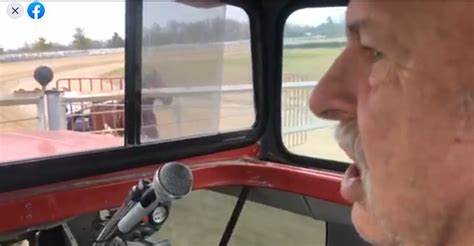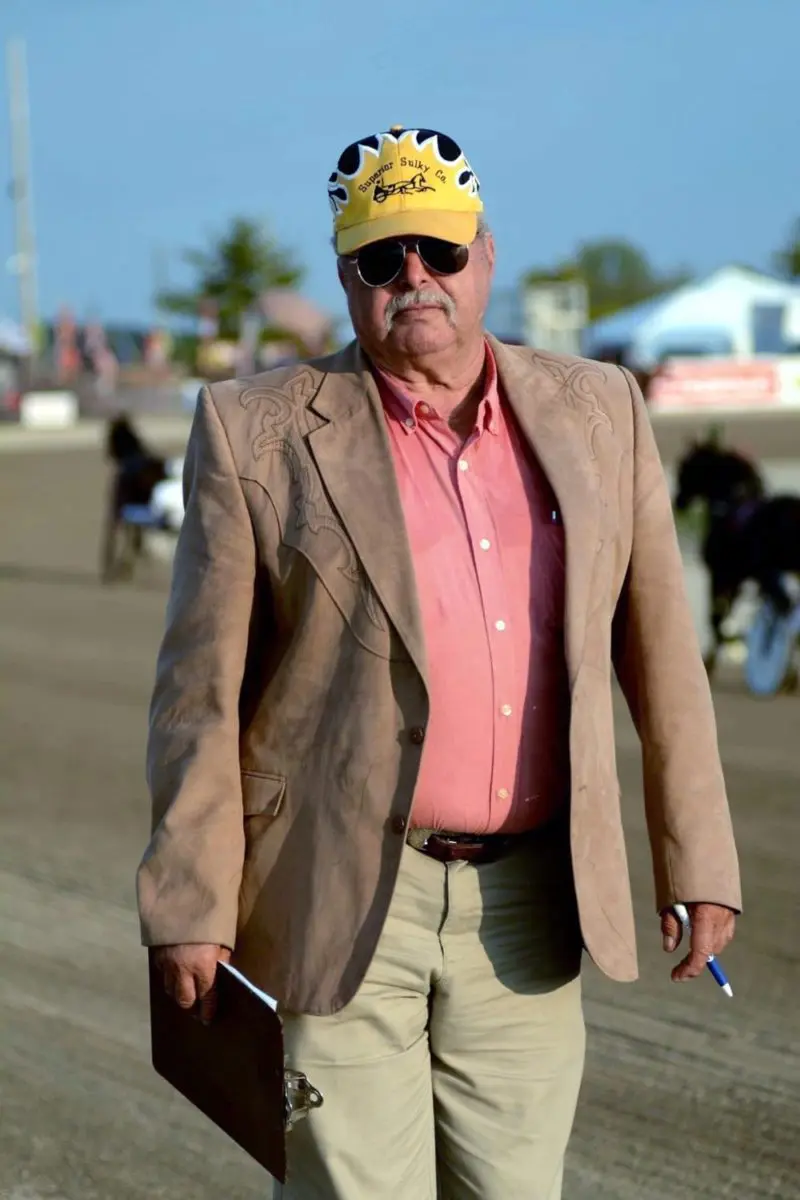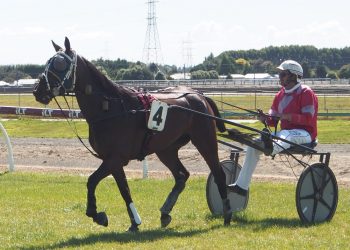Harness racing starter and gate manufacturer Mike Woebkenberg was recently honored with the sport’s top award of “Unsung Hero” by the U.S. Harness Writers Association (USHWA) at their annual Dan Patch Awards Banquet in Orlando, FL, on Feb. 21.

In 2022 the gregarious and glib Woebkenberg gave 518 rides in one of his gates that he utilizes throughout the Buckeye State at both pari-mutuel raceways and the county fairs, delighting numerous fans with the thrills of racing.
“The Unsung Hero Award was quite meaningful to me because it comes from the folks who are working on a daily basis to make the public aware of the great sport of harness racing,” Woebkenberg stated. “I think we have a great product, and a lot of times we are touting our sport to those already interested or involved in it, and what’s most frustrating to me is that a lot of the public still doesn’t know we exist.”
A lifelong horseman who resides in the southwestern corner of Ohio, along with his wife Becky, who usually drives the car for the races that Woebkenberg starts, has definite ideas of where he’d like to see harness racing progress in the future.
“I love this sport and I’m passionate about it,” he stressed. “I think we need to do more at the grass roots level, at the county fairs, to get people outside the sport to take note of the great product we have in harness racing.”

Woebkenberg’s proactive stance on publicizing the sport in Ohio is unparalleled. He works diligently on introducing folks to harness racing via grass roots, agricultural, and political involvement.
“I attend as many 4-H and farm bureau programs as I can,” he stressed. “Especially with the younger kids, my idea is that these are the folks who maybe in ten to 20 years will be on the fair board. I want them to like harness racing and to know it. I don’t want them as fair board members to say, ‘we don’t want harness racing, we don’t make any money on them.’
“The pari-mutuels go for so much money now in Ohio that the fairs purses can’t compare anymore,” He continued. “When I raced horses at the fairs it was completely different. Today, a $10,000 claimer can easily have $100,000 on their card.”
Woebkenberg also makes a point to get together with his state representative every few months, and says he wishes his fellow horsemen would do the same.
“My local, state representative Rodney Creech is the chairman of the agriculture committee for the state of Ohio,” he noted. “A group of us meet every Saturday at a local diner for breakfast and sometimes he’ll show up at my invitation. Can he save harness racing at all the fairs? Probably not, but I’ve established a relationship with him and if harness racing comes up during a legislative session, I’m fairly confident he’ll give me a call. It’s important to have those kinds of relationships if we want harness racing to thrive in the future. I’d venture to say that the average horseman in the paddock at Miami Valley has no idea who their state rep is.”
Woebkenberg said he would like to see each county fair in the state have a congressional pace or trot that recognizes that political person in their district and invite that person to hand out the blanket and stand in the winner’s circle.
“Our political impact is important,” he stressed. “The meet and greets are essential because as a constituent, the representatives need to know that if I live in your county, I’m going to vote for you based on your support of harness racing and the county fairs.

“We sadly miss so many opportunities to tell the average person how great our sport is,” he continued.
“The world has changed and we need to change with it. When I give folks rides in the gate, I explain what fantastic equine athletes these horses are, and the people are always excited and say what a great time they have had. I try to encourage folks to come out not just once a year, but once a month or as often as possible.”
Besides his starting duties, Woebkenberg also presides over a judge’s school every June at the Urbana County Fairgrounds and teaches a continuing education class for presiding judges.
“We have a plethora of catch-drivers in Ohio and if one doesn’t show up on any given night, there are plenty to take his place,” Woebkenberg admitted. “But judges are another story. There’s nobody standing in the wings to fill those seats.”
While Woebkenberg is thankful for what the harness writers and promoters do, he believes more could be done at the local level.
“Our fairs are our greatest venue and our greatest resource,” he said. “Granted, there’s been a ton of changes over the years—most of the county fair turns were made for :30 quarters, not :27 quarters—but they’re still vitally important to our industry, especially here in Ohio. The fairs are our minor leagues where get horses developed. We have 65 fairs in Ohio and Becky and I started 56 of them last year. Some of them aren’t profitable for us, but I know that if I didn’t work at some of those smaller fairs, they wouldn’t have harness racing. I go because I want to help the little guy and because I enjoy it.
“I probably say hello to more folks at a county fair than anywhere else,” he stressed. “People want to be recognized and there’s a hometown feeling when people stop and say hello and speak to one another. When I was growing up, we went to the fairs and set up our barn and stayed for three or four days. We ate breakfast at the church tent and bought things from the vendors on the grounds.
“Now, horsemen get there after the third race and leave after the 14, and we’re often perceived by the fair boards as ‘takers,’” Mike explained. “Especially when you have horsemen complaining about paying to get in or not having the parking spot, they feel they’re entitled to have. The horsemen have to do their part as well if we want good publicity. We have to be good visitors at the fairgrounds in order for the fair boards to support us. I always go out of my way to get fair board members to ride in the gate and to try to establish a friendly relationship with those folks.”
Woebkenberg said he feels the horsemen should entice the public to get up close and personal with the horses, rather than take a ‘stay away’ stance.
“Every pari-mutuel track and each county fair should have a table that says, ‘If it is your first time at the track, come here,’” he stated. “We should give them a program and teach them how to read it, give them a $2 betting voucher, and let them into the winner’s circle to get their picture taken. Also, the tracks and fairs should have a horse stationed in a small paddock either on the apron and let kids and adults pet a horse and see how cool that is.
“That kind of involvement would go a long way to getting people coming back to the races,” Mike added. “The core nucleus of county fair folks came to the fair because their grandfather brought their father, and it was a generational thing. I’d like to extend our outreach to the other folks at the fairs too. I want the guy from the cow barn, who is showing his prize steer, to walk up to the races at the fair and say, ‘that’s pretty neat, I might want to do that,’ about harness racing.”
For Woebkenberg and wife Becky, their first time attending the Dan Patch Awards a few weeks ago offered a new perspective on the North American racing scene.
“My observation is that a lot of the industry centers on The Meadowlands and some of the big breeding farms,” he said. “If you’re part of those groups, you’re special. But what people have to realize is that those venues are East Coast, they’re regional, and that our industry is supported more by the little guys. Those guys who come up north to race from the southern states, who have been supporting all these venues for so many years are going to be out of business soon.
“The influx of money is great in what I call the Golden Triangle of Miami Valley, Hoosier Park, and the Kentucky tracks” Mike concluded, “but that makes it tough for the little guys have a hard time competing against the bigger stables going for the bigger purses, which is why the county fairs are so important.”
Woebkenberg says it is important to reach outside of the county fair, agricultural community, or the pari-mutuels to spread the message of harness racing.
“When I go to a fair, I stop at a gas station on the way,” he said. “People always come up and ask about the starting gate, and I tell them that we’re racing and what time post is. I want those fair boards to know that I’m making an economic impact on their territory, and that’s something that anyone can do easily at the local level. I think too, if we had an educational video that we could present to the fair boards—and talk about how harness racing helps fund agriculture—that it would bode well for us.”
Ultimately, Woebkenberg says, it comes down to three things: “We need legislative involvement, we have to be better visitors, and we need to let more people know that we have the greatest sport going.”
by Kimberly Rinker, for Harnesslink

 USA
USA Canada
Canada Australia
Australia New Zealand
New Zealand Europe
Europe UK / IRE
UK / IRE



